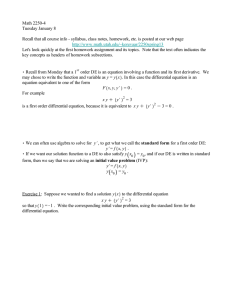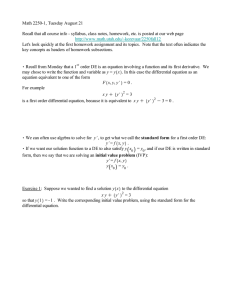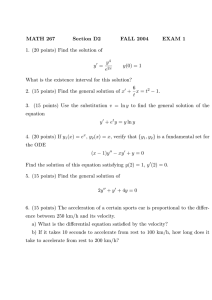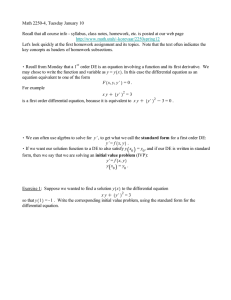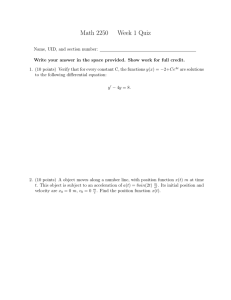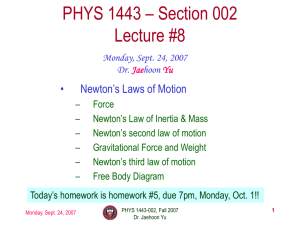Math 2250-4 Tuesday August 27
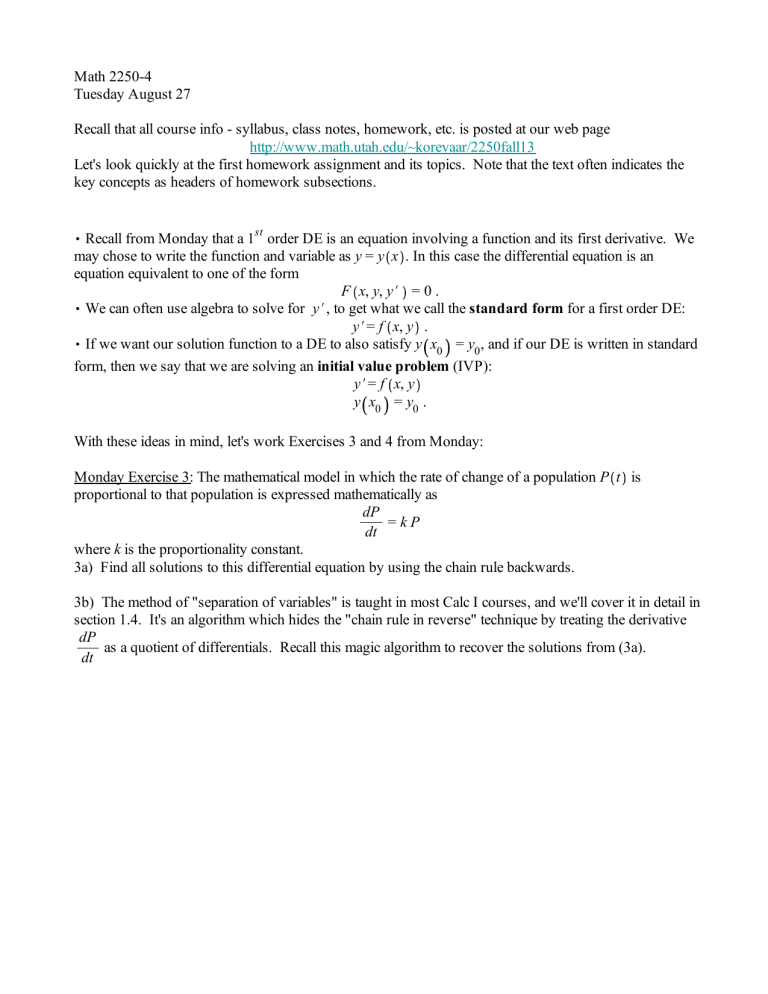
Math 2250-4
Tuesday August 27
Recall that all course info - syllabus, class notes, homework, etc. is posted at our web page http://www.math.utah.edu/~korevaar/2250fall13
Let's look quickly at the first homework assignment and its topics. Note that the text often indicates the key concepts as headers of homework subsections.
, Recall from Monday that a 1 st
order DE is an equation involving a function and its first derivative. We may chose to write the function and variable as y = y x . In this case the differential equation is an equation equivalent to one of the form
F x , y , y # = 0 .
, We can often use algebra to solve for y # , to get what we call the standard form for a first order DE: y # = f x , y .
, If we want our solution function to a DE to also satisfy y x
0
= y
0
, and if our DE is written in standard form, then we say that we are solving an initial value problem (IVP): y # = f x , y y x
0
= y
0
.
With these ideas in mind, let's work Exercises 3 and 4 from Monday:
Monday Exercise 3: The mathematical model in which the rate of change of a population P t is proportional to that population is expressed mathematically as dP dt
= k P where k is the proportionality constant.
3a) Find all solutions to this differential equation by using the chain rule backwards.
3b) The method of "separation of variables" is taught in most Calc I courses, and we'll cover it in detail in section 1.4. It's an algorithm which hides the "chain rule in reverse" technique by treating the derivative dP dt
as a quotient of differentials. Recall this magic algorithm to recover the solutions from (3a).
Monday Exercise 4) Newton's law of cooling is a model for how objects are heated or cooled by the temperature of an ambient medium surrounding them. In this model, the body temperature
T = T t changes at a rate proportional to to the difference between it and the ambient temperature A t . In the simplest models A is constant.
a) Use this model to derive the differential equation dT dt
= K k T K A .
b) Would the model have been correct if we wrote dT dt
= k T K A instead?
c) Use this model to partially solve a murder mystery: At 3:00 p.m. a deceased body is found. Its temperature is 70 + F. An hour later the body temperature has decreased to 60 inversion in SLC, with constant ambient temperature 30 +
+ . It's been a winter
. Assuming the Newton's law model, estimate the time of death. We can choose whether to use the "chain rule in reverse" explicitly, or whether to use separation of variables, the "magic" shortcut.
Section 1.2
: differential equations equivalent to ones of the form y # x = f x , which we solve by direct antidifferentiation.
An important class of such problems arises in physics usually as velocity/acceleration problems via
Newton's second law. Recall that if a particle is moving along a number line and if x t is the particle position function at time t , then the rate of change of x t (with respect to t ) namely x # t , is the velocity function. If we write x # t = v t then the rate of change of velocity v t , namely v # t , is called the acceleration function a t , i.e.
x ## t = v # t = a t .
Thus if a t is known, e.g. from Newton's second law that force equals mass times acceleration, then one can antidifferentiate once to find velocity, and one more time to find position.
Exercise 1: a) If the units for position are meters m and the units for time are seconds s , what are the units for velocity and acceleration? (These are mks units.) b) Same question, if we use the English system in which length is measure in feet and time in seconds.
Could you convert between mks units and English units?
Exercise 2:
Suppose the acceleration function is a negative constant K a , x ## t = K a .
(This could happen for vertical motion, e.g. near the earth's surface with a = g z 9.8 m s
2 z 32 ft s
2 well as in other situations.) a) Write x 0 = x
0
, v 0 = v
0
for the initial position and velocity. Find formulas for v t and x t .
b) Assuming x 0 = 0 and v
0
O 0 , show that the maximum value of x t is x max
=
1
2 v a
2
0
.
(This formula may help with some homework problems, as well as the one below.)
, as
Exercise 3: Car accident reconstruction. A driver skids 210 ft. after applying his brakes. He claims to the investigating officers that he was going 25 miles per hour before trying to stop. A police test of his vehicle shows that if the brakes are applied to force a skid at an initial speed of 25 mi h
then the auto skids only 45 ft . Assuming that the car is decelerating at a constant rate while skidding, about how fast was the driver really going?
